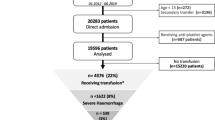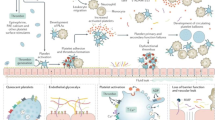Abstract
Objective: To study the influence of continuous administration of heparin on platelet function in intensive care patients. Design: Prospective, serial investigation. Setting: Clinical investigation on a surgical and neurosurgical intensive care unit in a university hospital. Patients: The study included 45 patients: 15 postoperative with patients sepsis (Acute Physiology and Chronic Health Evaluation II score between 15 and 25), 15 trauma patients (Injury Severity Score 15 to 25), and 15 neurosurgical patients. Interventions: Management of the patients was carried out according to the guidelines for modern intensive care therapy. Sepsis and trauma patients received standard (unfractionated) heparin continuously [aim: an activated partial thromboplastin time (aPTT) approximately 2.0 times normal value; sepsis-heparin and trauma-heparin patients], whereas neurosurgical patients received no heparin (neurosurgical patients). Measurements and results: From arterial blood samples, platelet aggregation was measured by the turbidimetric method. Platelet aggregation was induced by adenosine diphosphate (ADP; 2.0 μmol/l), collagen (10 μg/ml), and epinephrine (25 μmol/l). Measurements were carried out on the day of diagnosis of sepsis or 12 h after hemodynamic stabilization (trauma and neurosurgery patients) (baseline) and during the next 5 days at 12.00 noon. Standard coagulation parameters [platelet count and fibrinogen and antithrombin III (AT III) plasma concentrations] were also monitored. Heparin 4–10 U/kg per h (mean dose: approximately 500 U/h) was necessary to reach an aPTT of about 2.0 times normal. Platelet count was highest in the neurosurgical patients, but it did not decrease after heparin administration to the trauma and sepsis patients. AT III and fibrinogen plasma levels were similar in the three groups of patients. In the sepsis group, platelet aggregation variables decreased significantly (e. g., epinephrine-induced maximum platelet aggregation: − 45 relative % from baseline value). Platelet function recovered during the study and even exceeded baseline values (e. g., ADP-induced maximum platelet aggregation: + 42.5 relative % from baseline value). Continuous heparinization did not blunt this increase of platelet aggregation variables. In the heparinized trauma patients, platelet aggregation variables remained almost stable and were no different to platelet aggregation data in the untreated neurosurgical patients. Conclusions: Continuous administration of heparin with an average dose of approximately 500 U/h did not negatively influence platelet function in the trauma patients. Recovery from reduced platelet function in the sepsis group was not affected by continuous heparinization. Thus, continuous heparinization with this dose appears to be safe with regard to platelet function in the intensive care patient.
Similar content being viewed by others
Change history
11 April 2023
This article has been retracted. Please see the Retraction Notice for more detail: https://doi.org/10.1007/s00134-023-07057-0
Author information
Authors and Affiliations
Additional information
Received: 30 July 1996 Accepted: 10 February 1997
About this article
Cite this article
Boldt, J., Müller, M., Rothe, A. et al. RETRACTED ARTICLE: Does continuous heparinization influence platelet function in the intensive care patient?. Intensive Care Med 23, 567–573 (1997). https://doi.org/10.1007/s001340050374
Received:
Accepted:
Published:
Issue Date:
DOI: https://doi.org/10.1007/s001340050374




